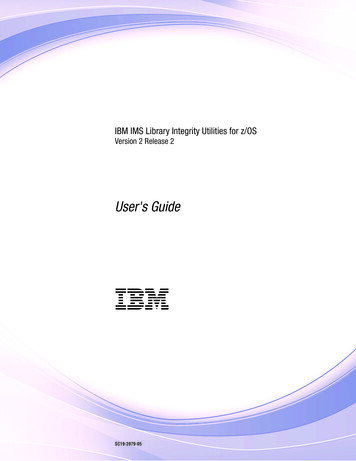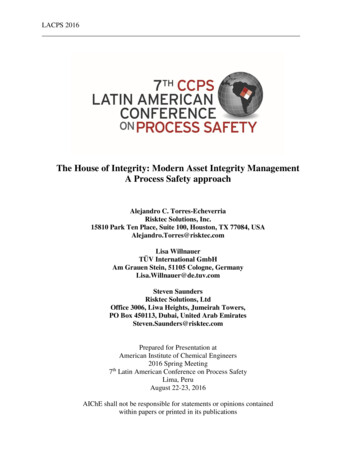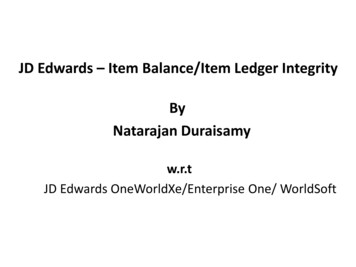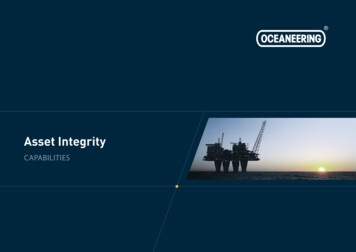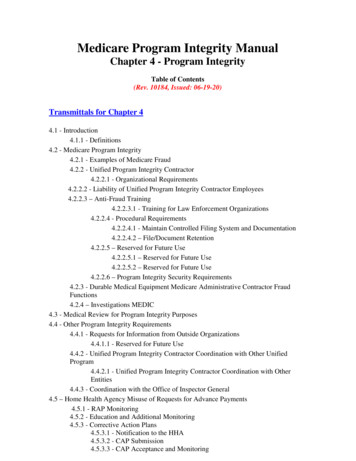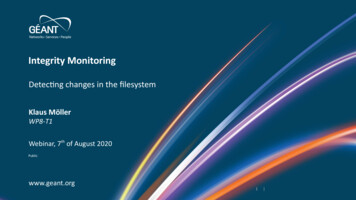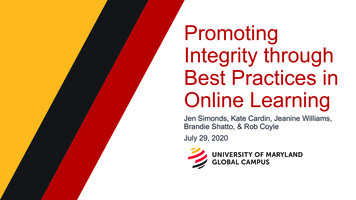
Transcription
PromotingIntegrity throughBest Practices inOnline LearningJen Simonds, Kate Cardin, Jeanine Williams,Brandie Shatto, & Rob CoyleJuly 29, 2020
Introductions
Agenda3Promoting IntegrityElements of High–Quality OnlineLearningAuthenticAssessmentsAdapting FavoriteActivitiesMaking Connections
How DesignSupportsIntegrity4 Reasons for cheating Design matters.“Best Way to Stop Cheating in OnlineCourses? ‘Teach Better’” – Inside HigherEd (7/22/20)
Use Your Messaging Focus on what TO do and good intentions Link students to policy and resources Prepare for skill gaps (Avoid ”They should know”without basis.) Use the language of the International Center forAcademic Integrity's 6 academic integrity values(honesty, trust, fairness, respect, responsibility,courage) Create community responsibility: We do this Discuss intrinsic goals for learning and skilldevelopment Convey “got you;” steer clear of “gotcha;” stayfocused on learning5
Context: What We’reTrying To AchieveEmergency remote learning not online learning Thinking in new ways Getting at the mostachievable outcome Recognizing opportunity6This Photo by Unknown Author is licensed under CC BY-NC
Backward DesignGrant Wiggins & Jay McTigheWhat do my students need to know andbe able to do?How do I check/assess their learning?What learning activities will lead to thedesired result?7
Competencies/Learning Objectives Articulate what students should be able to do as a result oftheir learning experiences (in a course, in a program, etc.) Must be clear, meaningful, student-centered, observableand measurable, appropriate, and aligned Serve as the "blueprint" for teaching and learning Facilitate integrity and success by making expectations,relationships, and purpose explicit for students8
Universal Design for Learning (UDL)9Affective NetworksRecognitionNetworksStrategic NetworksThe WHY of learningThe WHAT of learningThe HOW of learningProvide multiple means ofEngagementProvide multiple means ofRepresentationProvide multiple means ofAction & ExpressionFor purposeful, motivatedlearners, stimulate interestand motivation forlearning.For resourceful,knowledgeable learners,present information andcontent in different ways.For strategic, goal-directedlearners, differentiate theways that students canexpress what they know.CAST (2018). Universal Design for Learning Guidelines version 2.2. Retrieved from http://udlguidelines.cast.org
Scaffolding, Chunking, & SequencingScaffolding, chunking, and sequencing decrease performancepressure, increase confidenceIntro Psychology Example: Large high-stakes paper late in courseinto periodic smaller assignments that build to larger paper.10
First-Year Writing Course flectiveEssayResearchEssay11
FYW Course Weekly Learning ActivitiesReaderResponseInstructorFeedbackDrafting flectiveEssayResearchEssayPeer Review12GrammarPractice
Questions?
Your Classes: Poll Questions Synchronous/asynchronous: Will you have set class meetingtimes (synchronous) and/or may the learning and courseworkbe done at any time (asynchronous)? Class sizes: What are the largest classes you are preparing?14
Personalization, Differentiation, & Choice Personalization Learning that is tailored to the preferences of various learners, as wellas instruction that is paced to a student's unique needs. Differentiation via Academic goals Curriculum & content Method & pace Instead of education being something that happens to the learner, it issomething that occurs as a result of what the student is doing, with theintent of creating engaged students who have truly learned how tolearn (International Society for Technology in Education, 2018).15
Fostering Relationships with Students Student connection to faculty and classesincreases investment and integrity. Make your communication plan clear andinviting; make it feel personal How can students connect with you and theirclassmates?16This Photo by Unknown Author is licensed under CC BY
Providing Feedback to StudentsImmediate andOngoingFocus on 2-3 HighImpact FactorsWhole GroupFeedback17Use Peer ReviewAudio FeedbackAutomatedFeedbackVideo/Screencasting
Questions, Comments,Examples?
Authentic Assessments Enable students to apply their knowledge and skills tocomplex issues that are similar to those encountered inprofessional ("real-world") contexts Examples of projects at UMGC Graduate Undergraduate Facilitate integrity by establishing relevance, engagingstudents in active/applied learning, and requiringdemonstration of higher-order cognitive skills Increase motivation for original work19
Examples of Authentic Deliverables Advertisement (print,multimedia, audio, etc.) Artwork (photograph,painting, drawing, etc.) Bids or applications inresponse to a request forproposals Executive summary of areport Lesson plan20 Newspaper op-ed Policy brief Press release Profit and loss statement Project plan Software application (codeand technical documentation) UX wireframe Whitepaper
If you can't avoid using an exam:21 Align questions with the course's learning objectives Exam should not be the first time that students have beenassessed this way Create questions that elicit higher-order cognitive skills (upperlevels on the revised Bloom's Taxonomy) Consider contextualizing questions with scenarios and"provide your own example"-type questions Use a variety of question types Randomize both the questions and the answers; use "selectfrom set" for first questions and periodically throughout Modify wording of test bank questions Set limited time
Combatting “Study Help” WebsiteAssignment AvailabilityFor the small number who fing – last step after most timespent on engaging design Topic and assignment name rotation Change part of the assignment Personal examples22
Survey: Your Activities & Our Tips Student interaction Small group activities (including think/pair/share) & try andthen check in Whiteboarding Student group presentations23
Q&A
Final ThoughtsWhat are your key takeaways?25
Resources
Resources "Going Remote With Integrity" Webinar Series fromInternational Center for Academic Integrity (ICAI) General ICAI Video "Policy Gone Virtual" Video "Tech Tips and Techniques" Video About Universal Design for Learning from CAST Quality Matters (course design standards & training) Revised Bloom's Taxonomy ACTFL Teaching & Learning Remotely (foreign languages) Indiana University Center for Language Excellence27
Resources (continued) Harvard University "Resources for Remote Instruction ofLanguage Courses" Harvard University "Boardwork" (for online science courses) Classroom Assessment Techniques (some of these work online) Carnegie Mellon University "Solve a Teaching Problem"28
Institutional Academic Integrity LeadsInstitutionBowie State UniversityCoppin State UniversityFrostburg State UniversityFrostburg State UniversitySalisbury UniversityTowson UniversityTowson UniversityUniversity of BaltimoreUniversity of Maryland Ctr for Env. ScienceUniversity of Maryland Ctr for Env. ScienceUniversity of Maryland Eastern ShoreUniversity of Maryland Global CampusUniversity of Maryland Global CampusUniversity of Maryland, BaltimoreUniversity of Maryland, Baltimore CountyUniversity of Maryland, College Park29First st nBuskirkKnappBondJob TitleAssoc. Provost For Academic AffairsAsst. VP for Academic OperationsInterim Assoc. Provost/Assoc. Prof., PhilosophyProfessor, Recreation & Parks Mgmt ProgramAssoc. VP, Academic AffairsAsst. Provost, Faculty Ac. Ctr of ExcellenceAssoc. VP, Enrollment Mgmt & RegistrarAssistant ProvostProfessor and Interim VP for EducationProfessor, Chesapeake Biological LabAssoc. Professor, Faculty Assembly ChairAsst. VP for Academic Integrity & AccountabilityDean, Cybersecurity & Information TechnologyDeputy Chief Accountability OfficerAsst. Vice Provost, Ac. Standards and Policy Admin.Asst. Director, Office of Student Conduct
Additional resources that were gleaned from the chat session. Inside Higher ED: Best Way to Stop Cheating in Online Courses? 'Teach Better'Guidance on using remote boardwork can be found hereUMBC tool chart resource for leveraging apps for engagement and assessmentResources that people shared to boost student motivation and engagement in online courses:o Wipstero Flipgrido Lucidcharto Voicethreado Rocketbook Snapcasto Ziteboard2-Step Instructions for Self-Registering for USM OnTrack QM Workshops:o Step 1. Go to https://www.qmprogram.org/myqm/ and sign in if you have a QM account orclick "No, I am new here" to create an account.o Step 2. Once signed in, click here https://www.usmd.edu/cai/register-qm-workshops for alisting of USM OnTrack QM Workshops and to register (using the corresponding link on theright side of the table). Scroll down the page to see workshops that are being addedregularly.
Towson University Patricia Westerman Asst. Provost, Faculty Ac. Ctr of Excellence Towson University Bob Giordani Assoc. VP, Enrollment Mgmt & Registrar University of Baltimore Candace Caraco Assistant Provost University of Maryland Ctr for Env. Science Lawrence Sanford Professor and Interim VP for Education University of Maryland Ctr for Env.
